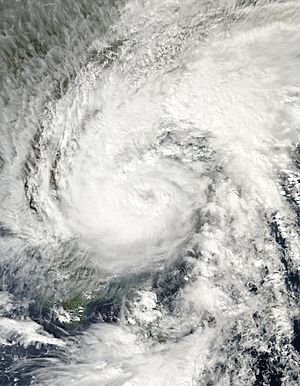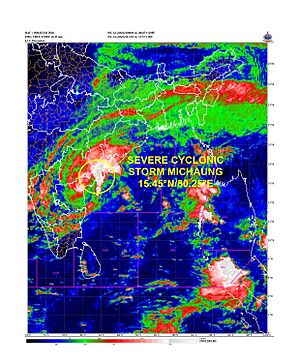Cyclone Michaung facts for kids

Cyclone Michaung on 4 December
|
|
| Meteorological history | |
|---|---|
| Formed | 1 December 2023 |
| Dissipated | 6 December 2023 |
| Unknown strength tropical cyclone | |
| 3-minute sustained (IMD) | |
| Highest winds | 100 km/h (65 mph) |
| Lowest pressure | 988 hPa (mbar); 29.18 inHg |
| Tropical storm | |
| 1-minute sustained (SSHWS/JTWC) | |
| Highest winds | 110 km/h (70 mph) |
| Lowest pressure | 988 hPa (mbar); 29.18 inHg |
| Overall effects | |
| Fatalities | 17 |
| Areas affected | India (particularly in Tamil Nadu and Andhra Pradesh) |
|
Part of the 2023 North Indian Ocean cyclone season |
|
Severe Cyclonic Storm Michaung was a powerful tropical cyclone. It formed over the Bay of Bengal near the south-eastern coast of India. The storm started as a low-pressure area in the Gulf of Thailand. It then moved into the Bay of Bengal. On December 2, it became a deep depression. Soon after, it grew into a cyclonic storm and was named Michaung.
Over the next few days, the cyclone moved north-west. It headed towards the east coast of India. Michaung had strong winds of up to 110 kilometers per hour (68 miles per hour). It brought very heavy rain to north-eastern Tamil Nadu, including Chennai. South-eastern Andhra Pradesh also got a lot of rain. The cyclone finally hit land near Bapatla in Andhra Pradesh on December 5.
Contents
What Does the Name Michaung Mean?
Michaung was the ninth depression of the season. It was also the sixth named cyclonic storm in the 2023 North Indian Ocean cyclone season. The country of Myanmar gave it the name Michaung. In the Burmese language, Michaung means 'strength and resilience'. You say it like 'Migjaum'.
How Cyclone Michaung Formed and Moved
In late November 2023, a low-pressure area moved into the Bay of Bengal. It came from the Gulf of Thailand. On December 1, the India Meteorological Department (IMD) announced something important. They said a depression had formed in the South Andaman Sea. This depression was expected to move north-west. It would also get stronger in the Bay of Bengal.
By December 2, the system became a deep depression. It was about 440 kilometers (273 miles) east-southeast of Puducherry. After that, it grew into a cyclonic storm. This is when Myanmar officially named it Michaung.
On December 4, Cyclone Michaung reached its strongest point. It was nearing the coast of Tamil Nadu. Its winds were about 110 kilometers per hour (68 miles per hour). This is like a strong tropical storm. Michaung then moved almost straight north along the coast. On December 5, the storm made landfall. It hit between Nellore and Machilipatnam in Andhra Pradesh. It got weaker as it moved inland. By December 6, the storm had become a depression. It was over central Andhra Pradesh.
Weather Information Gathered
Weather experts used the INSAT-3D satellite to watch Michaung. On December 5, the satellite showed a large cloud mass. It had broken low and medium clouds. There was also strong convection (rising air currents). This cloud mass covered the west-central Bay of Bengal. It also covered the coastal area of Andhra Pradesh. The coldest cloud top temperature was recorded at -90 degrees Celsius (-130 degrees Fahrenheit). Coastal weather stations reported a maximum wind speed of 60 knots (111 km/h or 69 mph). The lowest sea level pressure was 988 hPa (hectopascals). Nungambakkam in Chennai recorded the most rain. It got 53 centimeters (21 inches) of rain. This happened over three days, from December 2 to 4.
Getting Ready for the Storm
As the storm got closer to India's east coast, the weather department issued a red alert. This meant people needed to be very careful. In Tamil Nadu, over 500 people from the National Disaster Response Force (NDRF) and Tamil Nadu Disaster Response Force (TNDRF) were sent out. These groups help people during disasters.
They also set up many relief centers. There were 121 multi-purpose centers and 4,967 relief centers. These were in eight coastal districts of Tamil Nadu. They were ready to help people after the cyclone. In Andhra Pradesh, 181 relief camps were opened. These were across eight districts. The NDRF and AP State Disaster Response Force (APSDRF) each sent five teams. They helped in the areas affected by the storm. Southern parts of Odisha were also expected to get heavy rain. The Odisha Disaster Rapid Action Force was sent there to help local authorities.
What Happened Because of the Storm
Heavy rain and strong winds hit the coastal areas hard. Constant rains caused widespread flooding in Chennai. Chennai is the capital of Tamil Nadu. Rivers like Cooum and major lakes in Chennai overflowed. This made low-lying areas near the banks even more flooded.
Sadly, at least 17 people died. More than 41,000 people had to leave their homes. They were moved to safer places. This included 32,158 people in Tamil Nadu. Another 9,500 people were moved in Andhra Pradesh. The government cut off power in flooded parts of Chennai. This was to stop people from getting electric shocks.
Chennai International Airport stopped working on December 4. This was because the apron (where planes park) and runways were flooded. Flights were sent to other airports or canceled. The airport started working again the next day. Schools and offices were closed because of the heavy rains and flooding. Southern Railways and East Coast Railways changed or canceled many trains. Many businesses and factories in Chennai were affected. They had to stop working due to power cuts, flooding, and damage to their machines. In Andhra Pradesh, farmers reported damage to their crops. This was due to the flooding of their fields.
Helping After the Storm
The Indian Air Force helped by air dropping supplies. They dropped over 2,300 kilograms (5,070 pounds) of food packets and relief items in Chennai. The Indian Navy also helped. They worked with the Indian Army and National Disaster Response Force. Their job was to rescue people and give them supplies. They used inflatable boats for this.
The Greater Chennai Corporation sent more workers to help with flood recovery. They also helped people who were stuck. They said there were some delays in clearing fallen trees and garbage. This was because they didn't have enough staff. Volunteers also helped a lot. They gave out food packets, milk, and water bottles. They also rescued people stuck in flooded areas using boats.
See also
- Weather of 2023
- Tropical cyclones in 2023
- 2015 South Indian floods
Images for kids



